12: Wildlife and Forest Management
12. Wildlife and Forest Management
David Drake, Extension Wildlife Specialist, University of Wisconsin–Madison
Scott Craven, Extension Wildlife Specialist (Emeritus), University of Wisconsin–Madison
Reviewed and revised by David Drake in 2019
One of the most common reasons families offer for owning a woodland is to enjoy the wildlife it supports, whether by hunting, bird watching, photography or some other activity. When discussing management of forest-dwelling wildlife, it is impossible to separate wildlife management from woodland management, because the forest type and management activities directly affect the wildlife species that live within the forested habitat. In fact, management of some popular species, like ruffed grouse and woodcock, depends on timber harvesting. Woodland management for these species, and for forest products, affects many other species; some for the better—some for the worse. In some cases wildlife can affect woodland management. For example, high densities of deer can prevent regeneration of oak forests.
This chapter will first discuss harvest types related to wildlife management and wildlife species that tend to favor young forests (also referred to as early-successional forests). The discussion will then shift to species that prefer older, more mature stands or that occupy and travel freely between stands of diverse types and ages. The chapter ends with an overview of common challenges facing woodland owners.

The Midwest has an abundance of terrestrial vertebrate wildlife. Bird species are the most numerous, followed by mammals, reptiles, and amphibians. Most bird species in the Midwest are migratory. Some non-bird species, namely bats, are also migratory. Other birds, most of the mammals, and all of the reptile and amphibian species are considered resident species. Resident species typically stay relatively close to the area in which they were born. Whether a species is migratory or residential, or a bird, mammal, reptile, or amphibian, all species require suitable habitat to survive. A good wildlife identification field guide will provide at least a general understanding of species-specific habitat requirements.
To attract wildlife to your property, you must provide suitable habitat. Habitat consists of food, water, shelter, and space. Habitat can be provided naturally by planting the appropriate plant and tree species, by humans in the form of bird or wildlife feeders, landscape ponds, and nesting boxes, for example, or a combination of the two.
- Food: Most often, wildlife select food sources that provide the best nutrition while also being the most abundant and easiest to find. Seasonal variations in diet occur based on food availability (such as insects or fruits and berries), so the more food you provide on your property in all four seasons, the more wildlife the land will support year-round.
- Water: Nearly all wildlife species in the Midwest satisfy their water requirements by drinking from standing water or through their diet. The drier the food an animal eats, the more water from external sources it needs. For example, birds that eat seeds need proportionately more water than do carnivores (meat-eaters). Providing an available and open water source, especially in times of drought or extended periods of below-freezing temperatures, will ensure that wildlife have enough water. In addition to hydration, some wildlife use water as a source of shelter or safety. Waterfowl (ducks, geese, and swans) and some mammals (beavers, muskrats, and otters) feel safer on or in water than they do on land. Other wildlife like amphibians (frogs, toads, and salamanders) need water to complete their life cycle as they lay their eggs in aquatic habitats.
- Shelter: All wildlife species require shelter, sometimes to escape from predators, sometimes to stay warm and dry during winter storms. Shelter comes in many forms, and may consist of a hole in the ground, a cavity in a tree, or the space under an evergreen tree’s drooping branches.
- Space: Consider not only the size and shape of your property, but also the food, water, and shelter that are contained within your property’s boundaries. The proximity of food, water, and shelter need to be arranged so all of the habitat components are easily accessible to whichever species you are managing on your property. To manage for species such as wolves and bears that require large areas of habitat (that is, 50 to 150 square miles), you may need to cooperatively manage your forest property with neighboring landowners to create a larger block of habitat than you or a neighbor alone could provide.

As a general rule, the more diverse the habitat that is available, the more diverse the wildlife that habitat has the potential to attract and support. If your management objective is to increase biodiversity (maximize the number of species on your property to the extent possible), you’ll need to maximize habitat diversity on your property. This could entail managing for mixed species forests (for example, a variety of hardwood or softwood species, or a mixed hardwood and pine habitat), different aged stands, or stands that are both mixed species and mixed age. Alternatively, you may want to manage for one or a few wildlife species and indirectly benefit many other species that share the habitat. Be aware, however, that while some species may benefit from a particular set of management actions, the same wildlife management practices may not benefit–and may actually harm–other wildlife species.
Timber Harvests and Wildlife
Timber harvests provide forest products and economic return, but are also necessary to maintain healthy woodlands. No matter what type of harvest you plan for your woodland, all harvest types will have direct consequences for wildlife.
Clearcutting
Clearcutting results in even-aged stands of shade-intolerant trees. You can achieve a mix of age classes by clearcutting adjoining stands at different times. Clearcut areas provide large amounts of edge habitat, which is beneficial to wildlife that thrive where forest edges meet nonforested areas (such as white-tailed deer). Edges tend to provide abundant food sources. Clearcuts also increase stem density, thereby increasing the amount of cover for both prey and predator species. Clearcuts do not benefit wildlife species that require large and unbroken forest interiors (such as interior forest birds like the northern goshawk).
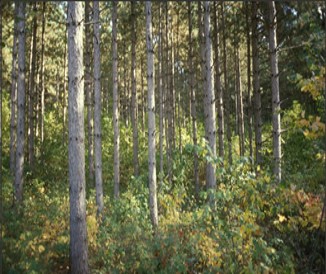
Shelterwood Harvests
Shelterwood harvests also result in even-aged stands and allow sunlight penetration to the ground over the entire harvest area. Shelterwood harvests typically remove up to 70 percent of the trees in a stand, and then a second cut occurring three to 15 years later removes the remaining mature trees. Shelterwood harvests are commonly used to regenerate oak species. Acorns from red and white oaks are a staple food for many species of wildlife (such as squirrels, deer and turkeys), so shelterwood harvests often provide abundant food sources for these species.
Timber Stand Improvement (Selective Harvests)
The most common form of timber stand improvement, or selective harvest, is thinning a stand to improve growing conditions for the remaining trees. Thinning allows more sunlight to penetrate to the forest floor. Additional sunlight will increase plant growth of wildlife cover and forage. Thinning also can open up the understory, allowing easier movement for wildlife.
Early Successional (Young) Forests and Associated Wildlife
In the upper Lake States, ruffed grouse are often the primary, or featured, species being managed for in an early-successional, or young, forest. Grouse are very popular as game birds and for their drumming behavior, explosive flushes, and beauty. Forest management for grouse affects an entire suite of species; therefore, we will use grouse management as an example to illustrate how forest and wildlife management go hand-in-hand. We will discuss how managing for one species often benefits many other species, and introduce some additional wildlife and forestry concepts.
Prime grouse habitat requires horizontal and vertical structure that is accomplished by managing a mix of three age classes of forest. Grouse reach their highest populations in aspen forest types. Aspen is the most common grouse habitat and the easiest in which to carry out the multiple age class management in which the birds thrive. Other forest types in the northern Lake States can provide grouse habitat, including conifers mixed with birch, red maple, alder, and hazel. In the southern half of many Lake States, dogwood, alder, hazel, prickly-ash, wild grape, oak, or red maple may provide habitat.
Aspen stands that are less than five years old are important brood habitat for hens and young chicks, and may also attract drumming males. Aspen stands that are six to 25 years old are most productive for grouse because they provide excellent cover for drumming males, nesting hens, and wintering adults. Stands older than 25 years provide the buds and catkins necessary for winter food and can include attractive nesting and brood-rearing cover.

Oaks are widely adaptable, but grow best in well-drained, upland soils. Oaks are usually lumped into two groups: the white oaks (white, swamp white, chinquapin, and bur oak) and the red oaks (northern red, black, and northern pin oak,). Oaks, especially young black and northern pin oaks, retain many leaves throughout the winter, providing insulation for grouse and other wildlife.
Oak-hickory woodlands are a valuable asset to wildlife in the Lake States. In addition to producing acorns and nuts (hard mast), they provide excellent sites for wildlife dens, nests, and roosts. The value of this forest type for grouse is directly related to the quantity and quality of understory vegetation. Oak and hickory are attractive to drumming males, nesting hens, and broods when mixed with low conifers, tall shrubs, and herbaceous food or cover plants.
Regardless of stand age or forest type, two crucial components of grouse habitat appear to be stem density and food production. Stands with a high density of vertical stems (sapling to pole-sized aspen, hazel, and other brush) protect male grouse when they are vulnerable to predators on their drumming logs. Areas with high densities of vertical stems also provide protection to the hen and her brood because avian predators cannot easily fly through the dense stands. Management prescriptions for grouse often specify desirable stem densities of 2,000 or more stems an acre.
For wildlife that require large areas to range across, you may provide only part of their required habitat on your land, while your neighbors provide the remainder. For example, at least 40 acres of good grouse habitat should be provided in a contiguous area. However, in areas where grouse habitat is abundant and in close proximity, you may provide only 20 acres on your property because other suitable grouse habitat surrounds your property. This is true with most wildlife–the better the quality of habitat, the less acreage is required to satisfy a particular species’ habitat requirements.
Always keep in mind a species’ home range requirements. Home range is the area necessary for a species to satisfy its habitat requirements. For species such as timber wolves or black bears that may need as much as 150 square miles to satisfy all of their habitat requirements, you are very unlikely to have the space necessary to hold them on your property 24 hours a day every day of the year. Instead, they may use your property, plus many other properties, to satisfy all their habitat needs. Cooperatively working with your neighbors to provide large blocks of contiguous habitat will benefit species that use large home ranges.
Late Successional (Mature) Forests and Associated Wildlife
Mature forests (also referred to as late successional forests) with large, full-grown, older trees are among the most structurally diverse ecological communities in the world. They provide three-dimensional habitat (forest floor, understory and mid-story layers, and canopy) in contrast to the one-dimensional habitat in early successional stands. Mature forests are home to more bird species, for example, than a field or young forest of comparable size. The more vertical layering a mature woods develops, the more places wildlife can live and forage for food. Remember, habitat diversity equals wildlife diversity. Do not overlook the value of snags (dead standing trees; three to five per acre are recommended) and fallen logs when developing the layered structure of your woods. To illustrate some management techniques beneficial to mature forest communities, we have selected several popular wildlife species found in this habitat.
Turkeys
In the upper Midwest turkeys have proven to be adaptable to a variety of habitat types. They have also extended their range further into northern forests than expected. Size of woodlot may not matter as much as the proper composition of turkey habitat. Mixed hardwood stands managed for mature timber interspersed with open areas provide good turkey habitat. To improve spring hunting success, provide nesting habitat to attract hens, and consequently, gobblers.

Turkeys prefer to roost in scattered tall trees with horizontal limbs, including conifers, that rise above the surrounding canopy. A variety of oaks, hickories, cherries, beech, and ash supply a steady source of mast. Selective cuts made in these stands to remove overstory trees will encourage dogwood, viburnum, hawthorn, grape, and other food-producing shrubs. Planting these and other species, such as apples, also may help attract turkeys to your property.
Woodpeckers, Wood Ducks, and Other Cavity Users
In addition to squirrels, raccoons, and other mammals, about 85 North American bird species (including woodpeckers and wood ducks) feed, nest, or roost in dead or decaying trees (also called snags). To manage for these species, preserve snags and potential snags. Use uneven-aged timber harvest and regeneration systems, leaving some trees to grow beyond their usual rotation age. These old trees will eventually degrade and form snags. A one-fifth acre clump of uncut trees within each five-acre harvest area will provide many wildlife species with snags of proper size (generally greater than nine inches DBH and six feet tall). Alternatively, you can create snags by girdling selected trees and spraying an appropriate herbicide into the girdled area to kill the trees. Cavity nesters also will use appropriately sized nest boxes.
The wood duck is one of the most popular woodland cavity nesters. Encourage nesting cavities or place nest boxes within one-half mile of a water source with good brood-rearing potential—generally, a wetland with emergent vegetation.
Songbirds
Most songbirds can handle some habitat change, such as moderate timber harvesting. Other species like wood thrush, pileated woodpecker, vireos, and many species of warblers and raptors are more sensitive to timber harvesting, especially if the harvest disturbs interior portions of the woodland.
Birds that breed in undisturbed forests share several important characteristics. They require an undisturbed, interior portion of a woodland for breeding and will not reproduce if a sufficient amount of undisturbed, interior woodland is not available. For example, opening the woodland interior through timber harvesting exposes these species to predators and nest parasitism from cowbirds. In addition, invasive plant species are more likely to invade a disturbed forest where the canopy is open and sunlight penetrates to the forest floor.
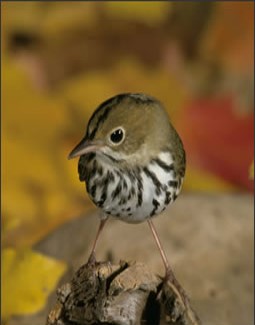
If you have a stand of mature northern hardwoods, aspen-birch, oaks, or mixed conifers and hardwoods, preserve as much uncut woodland and undergrowth as possible. Work with your neighbors to protect large blocks of mature, undisturbed woodlands. If you do harvest:
- Extend the rotation period where economically feasible.
- Cut a single, large tract, preferably along an existing edge or corner, rather than several small tracts in the interior.
- Preserve snags on the cut edge.
- Build brush piles with the slash to harbor insects on which songbirds feed and to provide shelter for a variety of wildlife.
Mammals
Woodlands with well-developed understories provide habitat for many mammals. Small mammals, such as chipmunks and white-footed mice, may spend their entire lives within an acre of woodland. In contrast, many furbearing predators (such as mink, skunk, raccoon, and fox) travel widely in search of food. Brushy stream borders, ravines, fence lines, and hedgerows connecting woodlots, fields, and wetlands provide these animals with travel corridors and hunting territory.
When logging or cutting firewood, leave hollow logs on the ground. You cannot sell them as saw timber and their value as firewood is small compared to their value as dens or shelter for ground-dwelling mammals. Depending on their diameter, these logs may be used by anything from the smallest shrew to the largest black bear.
A subset of mammals known as furbearers includes otters, mink, muskrats, beavers, and bobcats. Any mammal bearing fur is a furbearer, but the group of mammals traditionally known as furbearers are those that are trapped or hunted for their pelts. Two furbearers unique to mature coniferous and conifer-hardwood forests are pine martens and fishers, both members of the weasel family.
American pine martens are roughly the size of a house cat, with thick fur ranging in color from blond to reddish or dark brown. The fur color on the head of a marten can be lighter than the fur on the rest of the body, and all martens have a throat patch that can range in color from blond to bright orange or red. Martens eat small mammals, rabbits, birds, and some insects, fruit, vegetation and carrion, and are arboreal (that is, they live and forage primarily in trees). They require mature forests (that is, with a closed canopy) that have abundant vertical structure. Male martens use forests containing pole (trees measuring 4-9 inch diameter at breast height (DBH)) and saw log (trees greater than 9 inches DBH) sized trees, and females tend to select for pole-sized stands. Male and female den sites are in cavities in forests containing trees of at least 22 inches DBH. Large volumes of dead and downed woody debris on the forest floor are important for resting and foraging sites.
Adult male fishers are larger than martens, but female fishers can be of equivalent size to martens. Fishers are solidly dark brown to black in color. They have long, bushy tails that are usually a bit darker than the rest of their bodies. Like the marten, fishers are arboreal and eat a range of mammals from mice to rabbits to martens. Fishers are well known for being able to kill and eat porcupines. Fishers use habitats similar to those occupied by martens. Maternal den sites are typically found in large, hollow hardwood trees measuring at least 17 inches DBH. Fishers require a suitable amount of dead and downed woody debris on the forest floor for foraging, and closed canopies to provide protection from avian predators.
Reptiles and Amphibians
Forest-dwelling herptiles (reptiles and amphibians; often shortened to “herp”) live in forest wetlands, under leaf litter or loose bark, and in holes and crevices. Most woodland herp species depend on the moist, humid conditions found under the closed canopy of mature forests. Preserving or creating shallow ponds is one way to attract or hold herps on your property.
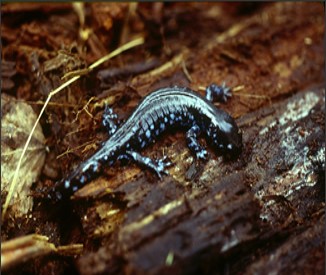
Many woodland amphibians breed in temporary, or vernal, ponds. Shallow ponds are best, but make sure they are deep enough to retain water until mid-August to allow larvae to develop completely. Permanent, deeper ponds will attract wetland species, such as bullfrogs and green frogs, which live in or near water year-round. Having both temporary and permanent ponds on your property will reduce competition between the larvae of woodland and wetland species and increase herp diversity.
If you have no permanent ponds on your property, create small ponds by digging out springs or potholes or by building weirs (small dikes or dams) in woodland ravines. On sandy soils, you will have to line the basin of an artificial pond with clay or plastic sheeting to enable it to hold water.
Before creating, modifying, or enhancing any wetland, you must become aware of all wetland laws, regulations, and permitting issues that may affect your plans. For more information, contact your local soil and water conservation district or Natural Resources Conservation Service office for guidance and regulations. Check with your local Extension office for helpful publications about ponds and herp habitat management. Amphibians, deer, turkey, and waterfowl will all use ponds, especially if they are built in or near wooded cover. However, if beaver are common in your area, don’t build an impoundment (manmade body of water) near any timber that you can’t afford to lose. What they don’t cut down, beavers might flood as they try to improve on your engineering.
Leaving unmerchantable logs to rot away on the forest floor benefits herps. They live in or under logs and feed on the invertebrates that are supported by the decaying wood. Rotting logs also provide a moist seedbed for mosses, fungi, ferns, and trees such as cedar and hemlock. Mortarless stone walls set off road or fence corners will provide homes for many herps and small mammals. Any little hiding place located near water is particularly good.
Wildlife Challenges
Wildlife management is more than just trying to increase the populations of animals a landowner wants to observe, photograph, hunt, or otherwise enjoy. In some cases, rare or endangered species may be present on a property, and you as a landowner may face legal or stewardship responsibilities for ensuring the well-being of such species and their habitats.
The mere presence of some species in a given area may be controversial, such as a wolf pack that is known to have attacked livestock or hunting dogs, or a deer population that has tested positive for chronic wasting disease. You may be faced with making decisions for the common good that might conflict with your own wishes.
Sometimes wildlife abundance is a problem. Many species can and do cause significant damage to forest ecology, agriculture, and even buildings and other property. Thus, management may need to be undertaken to reduce populations, rather than enhance them.
Wildlife Damage Management
The joys and satisfaction of successful wildlife attraction come with a price. Many wild animals can cause damage and nuisance problems ranging from trivial to severe. When facing any damage or nuisance problem that involves wildlife, several general considerations will improve your chances of successful problem resolution, keep you out of trouble with your neighbors or the law, and save you some effort and money.
- Identify the species causing the damage. Your first priority in effectively resolving wildlife damage is correctly identifying the wildlife species causing the problem. Occasionally you may observe the animal causing the damage. Most often, however, you’ll only discover the problem after the damage has occurred–a hole, missing produce, damaged landscape plants–and there is no animal present. In such cases you must do a little wildlife detective work to examine tooth marks, tracks, hair, droppings and other signs to determine the culprit. If you incorrectly identify the animal causing the problem, you risk applying a control technique that is inappropriate or ineffective for the situation or animal, ultimately wasting both time and money. Many good field guides can help you interpret signs.
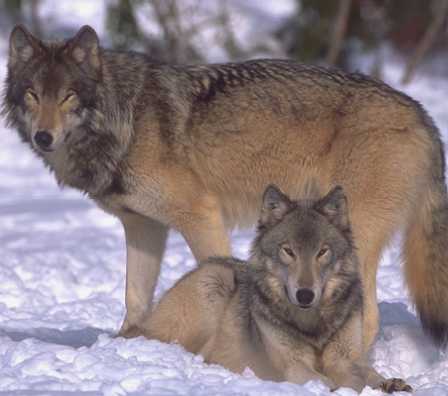
- Understand wildlife laws! You must find out what you can and cannot do legally with regard to harassing, relocating, or killing any wild animal, no matter what kinds of problems or damage it may be causing. It is legal to resolve most wildlife damage issues at any time of year using nonlethal techniques, so long as the animal causing the damage is not an endangered or threatened species and you are not making physical contact with the animal (i.e., trapping). The vast majority of wildlife, especially birds, are protected by state or federal law, or both! Permits, licenses, or other forms of permission may be required and even then, some actions—such as the use of toxicants on some species—will never be allowed. Laws also vary from state to state and even within some municipalities. If you have any doubt as to the legality of your planned actions, check first with a local department of natural resources conservation officer.
- Be proactive and persistent. Problems are often easier and cheaper to prevent than to stop once they occur. Animal problems become increasingly difficult to solve once animals have established a strong behavioral pattern in using a food source, nest site, or shelter. When it comes to wildlife damage, the adage “an ounce of prevention is worth a pound of cure” is certainly true.
- Spend your money wisely. The cost for different types of wildlife management practices to reduce or eliminate wildlife damage can range from almost nothing to thousands of dollars. The more expensive management practices do not always translate into increased effectiveness in solving damage problems. Before spending money on any management practice—especially the more expensive ones—estimate your annual economic loss from wildlife damage. Then you will be prepared to make educated decisions about how much money you might want to spend to reduce or eliminate the damage.
- Understand the basic tools and techniques of wildlife damage management. Wildlife control is very different from weed or insect control. Few chemical pesticides are registered (or available) for animal control, and “cookbook solutions”–apply X to Y for three days and then the problem is solved–are rare for wildlife problems. Animals often are highly mobile, wary and smart. Resolving a problem may require some trial and error and the use of an integrated control program involving a combination of nonlethal practices (such as exclusion, repellents, harassment, habitat modification, and increased tolerance) and lethal management practices. Success should be measured in terms of whether you have reduced a problem to tolerable levels. Complete elimination of an animal population is rarely achieved and generally not desirable.
Deer Management
Deer are arguably the most important wild animal over the entire Lake States region. As “keystone herbivores,” deer have the capacity to affect their own habitat and the habitat of other species. In many areas, especially in the southern part of the region, deer populations are well above wildlife management goals, creating problems for farmers, foresters, and motorists. In fact in many areas, the emphasis on deer management has shifted from habitat management to deer harvest management. However, deer are by far the number one big game animal in the region, providing hundreds of millions of dollars in positive economic impact. Therefore many woodlands are still valued and managed on the basis of their deer hunting potential.
Deer are very adaptable and can be found in any forest type, from suburban parkland to remnant old-growth stands. Their highest population levels tend to occur in areas with a mosaic of agriculture and woodlands, especially younger forests and mast-producing stands. In many cases landowners need to do little to ensure huntable deer numbers on their property.
In the northern part of the Lake States region, providing forest openings, seeded trails, and food plots, along with protecting historic deer yards, may help increase deer numbers.
Harvest management is used to:
- Reduce damage to forest regeneration, plantations, or nearby agricultural operations.
- Reduce deer densities as a disease management technique.
- Manipulate the sex and age structure of the herd to achieve hunting objectives such as older, “trophy” bucks or reducing the deer population by focusing on antlerless deer.
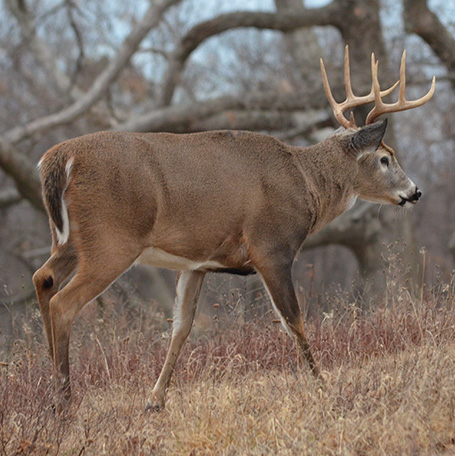
Landowners may choose their own goals and objectives for deer management, but must operate within the regulations set by their state wildlife agencies. Many helpful sources of detailed information (such as state agencies, deer management associations, and the internet) and of supplies (such as food plot seed and equipment, hunting equipment, and more) exist. Deer management is a passion for some landowners!
Keep in mind several current aspects of deer management:
- Deer feeding and baiting: These practices are very contentious. While nonhunters and hunters alike may enthusiastically feed deer for their own enjoyment or because they feel they are helping the herd, hunters bait deer in hopes of improving harvest opportunities. Most wildlife managers would like to see both practices eliminated, or at least tightly regulated. There is ample evidence to suggest that feeding changes deer movement patterns, affects deer nutrition, concentrates ecological impacts, facilitates disease transmission, and causes other management problems. Baiting is also questioned by some who think it gives the hunter an unfair advantage because it makes the game species more predictable. Changes in the culture of deer feeding and baiting are likely to be slow.
- Infectious disease: Another serious challenge to deer and deer management is the spread of infectious disease. Bovine tuberculosis (TB) has been a problem in Michigan for many years. In 2002 the discovery of chronic wasting disease (CWD) in Wisconsin set off a massive and costly management response throughout the region. These and other disease concerns mean that woodland owners should consider themselves part of the management team that is working to contain or eliminate disease in the deer herd.
Endangered and Threatened Species Management
The U.S. Fish and Wildlife Service defines a federally endangered species as a plant or animal that is in danger of going extinct throughout all or part of its range. A federally threatened species is a plant or animal that is in danger of becoming endangered throughout all or part of its range. In addition to federally endangered and threatened species, every state natural resources agency maintains a state endangered and threatened species list.
Species become endangered or threatened for a variety of reasons. Habitat destruction and over exploitation are historically two of the greatest causes of species becoming endangered or threatened. Introduction of non-native and/or invasive species, disease, and pollution are examples of other factors that can limit a species’ population. As a landowner, your ability to control some factors—such as disease and pollution—may be limited, but you can certainly control non-native, invasive species and habitat destruction on your property and help sustain rare populations. Check your state’s natural resources agency web site for a list of both federal and state endangered and threatened species in your area. Technical and cost-share assistance is usually available for landowners interested in managing for endangered and threatened species. Many landowners take great pride in knowing they are successfully managing for a rare species on their property, and that they may be the only property in the area where the rare species is found.
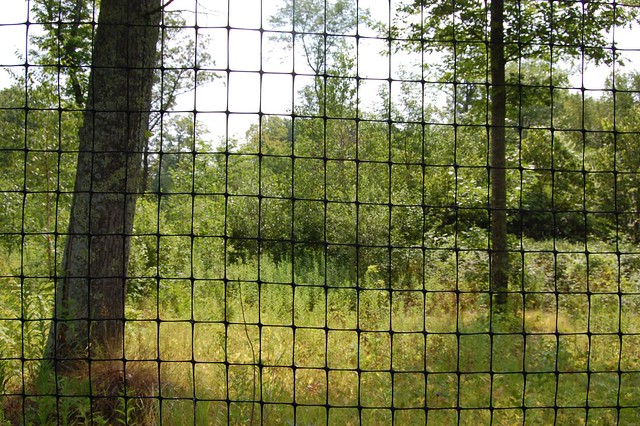
A species typically remains on the federal list or a state’s list for a long time. However, there have been a few species delisted due to protections afforded under the Endangered Species Act. The American alligator and bald eagle are two examples of successful delistings.
One recent success story specific to the Lake States region was the 2007 delisting of the region’s population of the gray (also referred to as timber) wolf. The gray wolf was deemed extinct in Wisconsin by 1960, and declining in numbers in Minnesota and Michigan as a result of habitat loss, bounties, and a decrease in the prey base. In 1974 the gray wolf was listed as endangered under the federal Endangered Species Act (ESA) and it became illegal to kill gray wolves. Habitat management was required to provide suitable habitat and space for the wolf to exist.
Due to these protections, excellent management by state and federal wildlife agencies working cooperatively, research efforts by agencies and universities, and private landowner cooperation and education, the gray wolf population grew to the point where wolves began to move into states such as Wisconsin (where no wolves existed) from states like Minnesota (which had a growing wolf population). Following the delisting of the Western Great Lakes wolf population and a subsequent wolf harvest in certain states due to a robust population, the gray wolf in the Great Lakes region is relisted as a protected species under the ESA due to political and legal challenges as of Spring 2019.
Another animal recently added to the Endangered Species list is the northern long-eared bat. This bat species is relevant to forestland owners because it is a forest dwelling species found throughout the upper Midwest and inhabits live and dead trees during the warm months of the year. Northern long-eared bats hibernate during the winter in caves and mines, and its population has been severely impacted by white-nose syndrome, a fungus that grows in areas where these bats hibernate. Because of concerns about the northern long-eared bat’s population decline due to white-nose syndrome, this species was declared federally threatened in 2015. However, the northern long-eared bat was listed under section 4(d) of the ESA. A 4(d) listing allows a species like the northern long-eared bat to receive focused protection under the ESA but also allows incidental take of the species in areas of the species’ range that does not contain white-nose syndrome. Incidental take is defined as the taking of a species that is incidental to, but not the purpose of, an activity like timber harvesting. Within the bat’s range that contains white-nose syndrome, limited incidental take may be allowed depending on the circumstances. Take of the northern long-eared bat to protect human life or property within or outside of the bat’s range containing white-nose syndrome is also allowed. Prior to undertaking any activities that may threaten the northern long-eared bats’ survival, it is recommended to consult with the U.S. Fish and Wildlife Service Region 3 (Midwest) office in Bloomington, MN.

